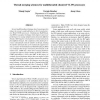Free Online Productivity Tools
i2Speak
i2Symbol
i2OCR
iTex2Img
iWeb2Print
iWeb2Shot
i2Type
iPdf2Split
iPdf2Merge
i2Bopomofo
i2Arabic
i2Style
i2Image
i2PDF
iLatex2Rtf
Sci2ools
ICPP
2009
IEEE
2009
IEEE
Thread Merging Schemes for Multithreaded Clustered VLIW Processors
Several multithreading techniques have been proposed to reduce the resource underutilization in Very Long Instruction Word (VLIW) processors. Simultaneous MultiThreading (SMT) is a popular technique which improves processor performance by issuing multiple instructions from different threads. SMT requires extra hardware to merge instructions from different threads. The complexity of this hardware increases substantially with the number of threads, limiting the number of threads that can be realistically supported to only 2. Cluster-level Simultaneous MultiThreading (CSMT) is a technique that merges instructions from threads at the cluster level. CSMT has a much lower merging hardware cost and can support a larger number of threads. However, CSMT performance is lower than SMT. In this paper, we evaluate several hardware designs that can support a high number of threads by using a merging scheme that combines both SMT and CSMT merging. For instance, one of the evaluated schemes, which me...
| Added | 19 Feb 2011 |
| Updated | 19 Feb 2011 |
| Type | Journal |
| Year | 2009 |
| Where | ICPP |
| Authors | Manoj Gupta, Fermín Sánchez, Josep Llosa |
Comments (0)

